
Bệnh viện Trung ương Huế
12 Journal of Clinical Medicine - Hue Central Hospital - Volume 17, number 2 - 2025
Evaluation of the results of the 1 - minute sit - to - stand test...
Received: 08/11/2024. Revised: 01/01/2025. Accepted: 10/01/2025.
Corresponding author: Ha Chan Nhan. Email: hcnhan@huemed-univ.edu.vn. Phone: 0905604006
DOI: 10.38103/jcmhch.17.2.2 Original research
EVALUATION OF THE RESULTS OF THE 1 - MINUTE SIT - TO - STAND TEST
AND RELATED FACTORS IN COPD PATIENTS
Ha Chan Nhan1, Bui Trung Vinh2, Dinh Thi Tuong Vy2, Pham Van Tai2, Do Minh Tam Hai2,
Nguyen Duc Thinh2, Hoang Nguyen Phuong2
1Rehabilitation Department, Hue University of Medicine and Pharmacy, Hue University, Vietnam
2Medical student, Hue University of Medicine and Pharmacy, Hue University, Vietnam
ABSTRACT
Objectives: To evaluate exercise capacity using the 1-minute sit-to-stand test (1MSTST) and investigate factors
related to the results of the 1MSTST in patients with chronic obstructive pulmonary disease (COPD).
Methods: A cross-sectional study was conducted on 61 stable COPD patients being hospitalized at Hue University
of Medicine and Pharmacy Hospital. Clinical characteristics were collected, and the 1MSTST was performed. The data
were analyzed to study factors related to the results of the 1MSTST.
Results: The average number of 1MSTST repetitions was 17.56 ± 6.76 times. The ≤ 60 - year - old group showed
better performance in the 1MSTST compared to the > 60 - year - old group. The COPD group A and B showed
better performance in the 1MSTST compared to the COPD group E. The number of 1MSTST repetition decreased
progressively from mMRC = 0 to mMRC = 4. The CAT < 10 group showed better performance in the 1MSTST
compared to the CAT ≥ 10 group. The CCQ total ≤ 3 group showed better performance in the 1MSTST compared to
the CCQ total > 3 group. There was an inverse correlation between 1MSTST performance and the following factors:
disease duration (r = -0.338), number of COPD exacerbations requiring hospitalization per year (r = -0.346), mMRC
(r = -0.669), CAT (r = -0.588), CCQ total (r = -0.592), CCQ symptoms (r = -0.419), CCQ functional state (r = -0.612),
and CCQ mental state (r = -0.532). The results were statistically significant with p < 0.05.
Conclusion: The number of 1MSTST repetitions was performed in patients > 60 years old, patients had more
symptoms, a higher exacerbation risk, and a longer disease duration, is significantly lower compared to patients ≤ 60
years old, patients had few symptoms, a lower exacerbation risk, and a shorter disease duration.
Keywords: Chronic obstructive pulmonary disease (COPD), exercise capacity, functional status, 1-minute sit-to-
stand test (1MSTST)
I. INTRODUCTION
Chronic Obstructive Pulmonary Disease
(COPD) is a common condition in the community,
characterized by irreversible airway obstruction.
The most common causes are exposure to tobacco
smoke, air pollution, and, to a smaller extent, gene
mutations. COPD is a condition that cannot be
completely cured and is one of the leading causes
of death worldwide as well as in Vietnam. COPD
patients experience reduced respiratory function
and limitations in performing daily activities, which
negatively impact their quality of life [1].
Exercise capacity is an important aspect in the
assessment of COPD patients. Currently, exercise
capacity is used to predict the patient’s condition and
the effectiveness of therapeutic interventions [2].
Several tests have been developed that are simple to
perform, do not require sophisticated or expensive
equipment, and can be conducted in a comfortable
setting, while still effectively assessing the patient’s

Bệnh viện Trung ương Huế
Journal of Clinical Medicine - Hue Central Hospital - Volume 17, number 2 - 2025 13
Evaluation of the results of the 1 - minute sit - to - stand test...
exercise capacity. The most commonly used of these
tests is the 6-minute walk test (6MWT). However,
assessment can be challenging when a long enough
hallway is not always available in hospitals or
clinics to complete the test.
An alternative solution that patients can perform
in a smaller space is the 1-minute sit-to-stand test
(1MSTST). The 1MSTST was first described by
Koufaki and colleagues in 2002 [3] and has recently
been more frequently studied and applied in clinical
settings due to its benefits [4], [5].
Therefore, we conducted this research with
the following two objectives: (1) To evaluate the
number of 1MSTST repetitions in COPD patients.
(2) To investigate factors related to the number of
1MSTST repetitions in COPD patients.
II. MATERIALS AND METHODS
2.1. Study subjects
The study included 61 COPD patients who met
the inclusion criteria and did not meet any of the
exclusion criteria.
Inclusion criteria: Stable COPD patients from
groups (A, B, E), diagnosed according to the
guidelines of the Global Initiative for Chronic
Obstructive Lung Disease (GOLD 2024), who were
receiving treatment at Hue University of Medicine
and Pharmacy Hospital.
Exclusion criteria: Participants were excluded
if they met any of the following conditions: Acute
exacerbation of COPD. Limitations in lower
limb mobility due to neurological conditions,
musculoskeletal disorders, peripheral vascular
diseases, or unstable cardiovascular conditions
(e.g., myocardial infarction within the past
month, unstable coronary artery disease, acute
exacerbation of chronic heart failure, etc.). Lower
limb surgery within the past 3 months. Current use
of stimulants. Presence of abnormal symptoms
(e.g., vomiting, nausea, dizziness, etc.). Inability
to understand the study procedures or refusal
to participate due to language barriers or other
reasons [6].
2.2. Methods
We carried out a cross - sectional study at
the Department of General Internal Medicine -
Endocrinology - Rheumatology, Hue University
of Medicine and Pharmacy Hospital, from March
2024 to October 2024. A convenience sampling
method was used, including all patients who met the
inclusion criteria.
How to Perform 1MSTST: According to
Bohannon RW and colleagues, the patient sits
upright in a chair. Upon hearing the command
“Start,” the patient stands up and sits down,
repeating the movement as many times as
possible within 1 minute. The number of sit-to-
stand repetitions within 1 minute is recorded and
referred to as the variable “Number of 1MSTST
repetitions” [7].
Place of Implementation: The 1MSTST is
performed in a treatment room where all necessary
equipment is available, and medical staff are present
to intervene if any abnormalities arise.
Study Procedure: Before performing the
1MSTST, the following assessments were
conducted: mMRC (Modified Medical Research
Council) to evaluate breathlessness severity [8],
CAT (COPD Assessment Test) to assess the severity
of COPD symptoms [9], and CCQ (Clinical COPD
Questionnaire) to evaluate the clinical status of
COPD over the past week [10]. The 1MSTST was
performed at a single time point when the COPD
patient was stable, prior to discharge. The following
variables were assessed before and immediately
after the 1MSTST: pulse, systolic blood pressure
(SBP), diastolic blood pressure (DBP), respiratory
rate, SpO2, and the BORG-10 scale. The number of
sit-to-stand repetitions (or cycles of 1MSTST) was
recorded, along with any symptoms experienced by
the patient, such as coughing, shortness of breath,
or chest pain.
Data collection tools: Questionnaire, watch,
blood pressure monitor, stethoscope, oximeter, chair
without armrests (45 – 48 cm height), measuring
tape, scale.
2.3. Data analysis
Data were analyzed using SPSS 26.0 software
with descriptive statistical methods. Differences were
assessed, and the level of correlation was evaluated
using Pearson or Spearman correlation analysis. A
linear regression model was used to determine the
regression line. Excel 2021 and MedCalc software
were used to calculate experimental parameters and
generate charts.

Bệnh viện Trung ương Huế
14 Journal of Clinical Medicine - Hue Central Hospital - Volume 17, number 2 - 2025
Evaluation of the results of the 1 - minute sit - to - stand test...
2.4. Research ethics
The research project was approved by the
Research Proposal Review Board of Hue University
of Medicine and Pharmacy and was officially
authorized under Decision No. 1179/QD-DHYD on
March 22, 2024. Participants were fully informed
about the study’s objectives and voluntarily agreed
to participate in accordance with the principles of
the Declaration of Helsinki. Participant safety was
ensured throughout the study.
III. RESULTS
3.1. Participant characteristics
The study included 61 patients, with a mean age of 67.87 ± 8.22. The majority were > 60 years old
(80.3%) and were male (98.4%). Other characteristics of the study subjects are described in Table 1.
Table 1: Participant characteristics
Variables N %
Age
≤ 60 12 19.7
> 60 49 80.3
X ± SD 67.87 ± 8.22
Gender Male 60 98.4
Female 1 1.6
BMI (kg/m2)
< 23 46 75.4
≥ 23 15 24.6
X ± SD 20.48 ± 3.52
Smoking 59 96.7
Chronic heart failure 3 4.9
Treatment adherence 41 67.2
Number of COPD exacerbations hospitalized/year
(Median (Quarterile)) 1 (1 - 2)
mMRC
0 8 13.1
111 18.0
2 20 32.8
3 18 29.5
4 4 6.6
X ± SD 1.98 ± 1.13
CAT
< 10 15 24.6
≥ 10 46 75.4
X ± SD 15.64 ± 7.48
CCQ total
≤ 3 49 80.3
> 3 12 19.7
X ± SD 2.22 ± 0.94

Bệnh viện Trung ương Huế
Journal of Clinical Medicine - Hue Central Hospital - Volume 17, number 2 - 2025 15
Evaluation of the results of the 1 - minute sit - to - stand test...
Variables N %
CCQ symptom X ± SD 2.62 ± 0.90
CCQ functional state X ± SD 2.24 ± 1.18
CCQ mental state X ± SD 1.43 ± 1.23
COPD group
A11 18.0
B 13 21.3
E 37 60.7
3.2. The number of 1MSTST repetitions
The average number of times the study subjects performed 1MSTST was 17.56 ± 6.76, with the highest
being 34 times and the lowest being 5 times. After performing 1MSTST, vital signs such as pulse, SBP,
DBP, respiratory rate and BORG-10 score all increased, SpO2 decreased. The above differences were all
statistically significant with p < 0.001 (Table 2). No warning symptoms appeared after performing 1MSTST
in our study subjects.
Table 2: Vital signs of subjects before and after performing 1MSTST
Vital signs Before After Variation p
Pulse (rates/minute) 84.54 ± 13.11 96.08 ± 13.80 11 (8 - 14) < 0.001
SBP (mmHg) 120.98 ± 11.79 135.25 ± 12.30 10 (10 - 20) < 0.001
SpO2 (%) 97 (96 - 98) 95 (93 - 97) 2.25 ± 1.19 < 0.001
BORG-10 1.08 ± 1.35 3.48 ± 1.96 2.39 ± 1.13 < 0.001
Number of 1MSTST repetitions 17.56 ± 6.76 (min - max: 5 - 34) (repetitions)
3.3. Correlation between participant characteristics and the number of 1MSTST repetitions
The group of patients aged ≤ 60 years had a higher average number of 1MSTST repetition compared
to the group of patients aged > 60 years (p < 0.05). There was no significant difference in the number of
1MSTST repetition between the two groups of smokers: those smoking > 30 pack - years and those smoking
≤ 30 pack - years. The COPD patient group without comorbid chronic heart failure had a higher number of
1MSTST repetition compared to the group with comorbid chronic heart failure (p < 0.05) (Table 3).
Table 3: Correlation of characteristics with the number of 1MSTST repetitions
Variables The number of 1MSTST repetitions
(repetitions) p
Age ≤ 60 years old > 60 years old 0.007
22.17 ± 5.94 16.43 ± 6.52
Smoking ≤ 30 pack - years > 30 pack - years 0.532
18.26 ± 6.48 17.13 ± 6.98
Yes No
Chronic heart failure 8.67 ± 4.73 18.02 ± 6.56 0.018
Maintenance treatment compliance 17.46 ± 6.96 17.75 ± 6.53 0.878

Bệnh viện Trung ương Huế
16 Journal of Clinical Medicine - Hue Central Hospital - Volume 17, number 2 - 2025
Evaluation of the results of the 1 - minute sit - to - stand test...
Figure 1 compares the number of 1MSTST repetitions in subgroups according to each scale. The
average number of 1MSTST repetitions tend to decrease from group A, group B to group E; decreasing
from mMRC = 0 to mMRC = 4. The CAT < 10 group has a higher number of 1MSTST repetitions than the
CAT ≥ 10 group. The CCQ total ≤ 3 group has a higher number of 1MSTST repetitions than the CCQ total
> 3 group (p < 0.05).
Figure 1: Correlation between COPD assessment scales and the number of 1MSTST repetitions
There was a negative correlation between
1MSTST and age (r = -0.225) and number of pack-
years (r = -0.074). In contrast, there was a positive
correlation between 1MSTST and BMI (r = 0.112).
However, all of the above correlations were not
statistically significant with p > 0.05. There was
a positive correlation between 1MSTST and
SpO2 (r = 0.322, p < 0.05). There was a negative
correlation between 1MSTST and BORG-10 (r =
-0.578, p < 0.001).
There was a negative correlation between
1MSTST and COPD duration (r = -0.338), number
of COPD exacerbations/year (r = -0.346), mMRC (r
= -0.669), CAT (r = -0.588), CCQ total (r = -0.592),
CCQ symptom (r = -0.419), CCQ functional state (r
= -0.612), CCQ mental state (r = -0.532) (p < 0.01),
in which mMRC and CCQ functional state were the
two indices with the strongest correlation with the
number of 1MSTST repetitions (Table 4).
Table 4: Correlation of COPD assessment
indicators and the number of 1MSTST repetitions
COPD assessment
indicators r p
COPD duration -0.338 0.008
Number of COPD
exacerbations/year -0.346 0.006
mMRC -0.669 < 0.001
CAT -0.588 < 0.001
CCQ total -0.592 < 0.001
CCQ symptom -0.419 < 0.001
CCQ functional state -0.612 < 0.001
CCQ mental state -0.532 < 0.001











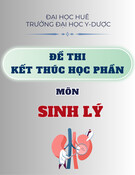


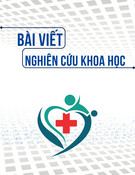

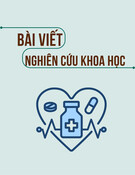


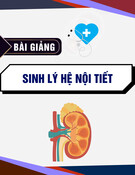
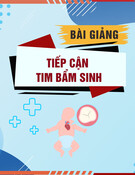

![Bài giảng Cập nhật vấn đề hồi sức bệnh tay chân miệng nặng [mới nhất]](https://cdn.tailieu.vn/images/document/thumbnail/2025/20250920/hmn03091998@gmail.com/135x160/23301758514697.jpg)



